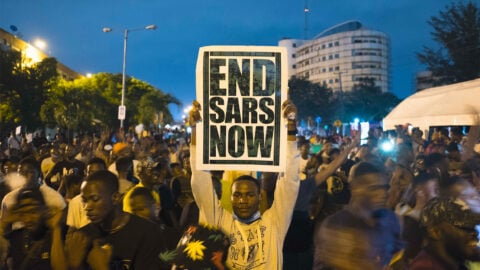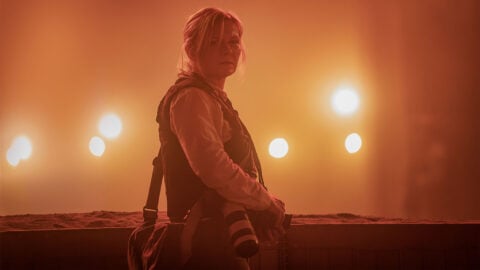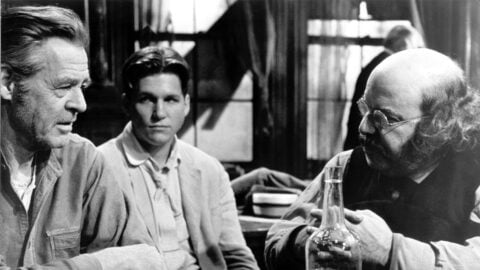Interview: Jessica Sarah Rinland
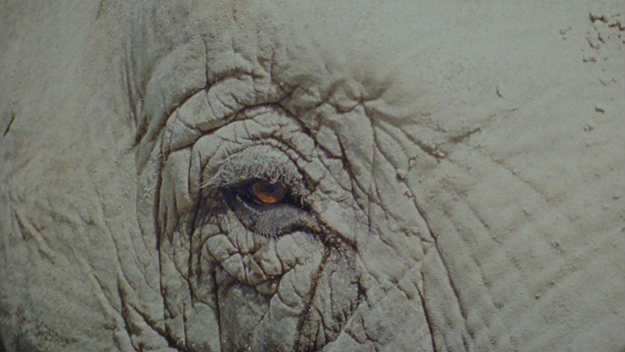
Those That, at a Distance, Resemble Another (Jessica Sarah Rinland, 2019)
In Jessica Sarah Rinland’s new film, Those That, at a Distance, Resemble Another, an elephant’s tusk becomes an object of dramatic intrigue. Furthering the Argentinian-British artist-filmmaker’s interest in nature, zoology, and the art of preservation, this globetrotting work of creative nonfiction—Rinland’s first feature following a decade of formally adventurous short and medium-length films, gallery work, and photography—skillfully traces the production of a replica pachyderm tooth dating from the late 19th century. Shooting on rich 16mm at Harvard’s Straus Center for Conservation and Technical Studies, Rinland not only observes the creation of the tusk, but assists in its construction, her pink-polished fingernails acting as a strikingly tactile visual guide as the ivory is slowly molded, shaped, and sanded by hand into an institutional artifact fit for public display. Nimbly crosscut with a number of related examples of museological conservation at art institutions across Britain and Brazil, the film (itself part of a larger project than also includes a book) presents a slipstream of textures and techniques that together reflect on the nature of representation and authenticity in the modern world. With a sensory attention to hands, surfaces, and the aural dimensions of each location, Rinland—who, in addition to directing, also shot, edited, and fashioned the film’s intricate Foley effects herself—has crafted one of the year’s most aesthetically intoxicating and subtly thought-provoking new films.
Following Those That, at a Distance, Resemble Another’s premiere at the Locarno Film Festival and its North American bow in the Wavelengths program at TIFF, Rinland and I spoke about her instinctual approach to form, implicating herself in her own process, her work’s relationship to narrative, and how her meticulous use of sound can’t be reduced to mere ASMR signifiers.
Those That, at a Distance, Resemble Another screens at the Viennale on November 2 and 3.
Can you tell me a little about your background and how you came to filmmaking? Your films deal with subjects—nature, science, archives and institutions, the body, marine biology—that suggest a variety of interests.
I came to cinema as I’ve come to these themes—one thing leads me to another: a conversation, an encounter, something I read or see. I encountered a stranded sperm whale, for example, huge and flattened—a group of vets and marine biologists were performing a necropsy. I spoke to them, asked them what had happened. They had theories including that the evolutionary memory of whales being land animals leads them to stranding, but overall they did not know. They didn’t have a concrete answer but were filled with curiosity. They told me about other marine biologists who I then met and filmed with; curators of mammals at museums; fanatic whale authors who I then collaborated with, and so on. While I was in the northern Patagonia hearing whales singing, someone I met mentioned that his brother was a biologist working on a reintroduction program in the north of Argentina. A week later I was on a bus up to los Esteros del Iberá.
As another example, a few years ago I was on one of my regular walks in the nearby woods and I noticed more trees being felled than usual. I went to the local government body, the owners of the land, to ask why—there I met the countryside manager who showed me his archive and led me to the local natural history society who I then spent five years joining on walks, filming, and recording our conversations, many of which were filled with curiosity and questions: “It’s amazing how many things are attracted to light.” Although the film might be finished, I still join the society on walks.
In 2015 I was working as an editor at the Tate and had read about a room filled with replicas at the Louvre which were made for people who weren’t able to see with their eyes and were invited to experience the sculptures through touch. I asked a colleague at the Tate if there was anything like this at this museum and they mentioned that every so often there are tours. I was introduced to David Johnson, a sculptor and piano tuner who lost his sight at nine who was a regular on touch tours. At a similar time, a friend who was working at the V&A, knowing my interest in “large mammals” told me that he’d overheard someone in the staff canteen talk about a cupboard filled with ivory. This lead me to making Those That, at a Distance, Resemble Another. Although my films Nuelpsy (2010), Adeline for Leaves (2014), and The Flight of an Ostrich (Schools Interior) (2016), are more methodical in process, this way of making can be applied to most of my work, including Expression of the Sightless (2016), Black Pond (2018), and Those That, at a Distance.
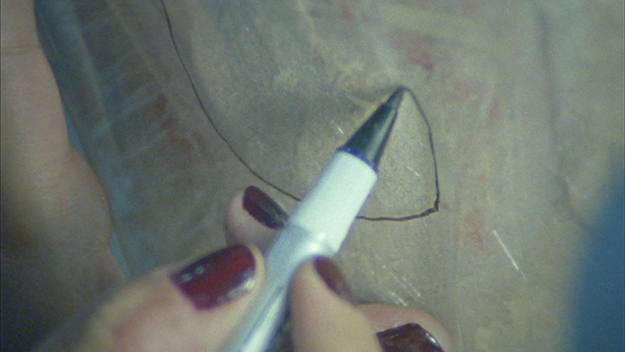
Aesthetically the films seem to have become somewhat more refined over that time. I’m curious how you see your subjects in relation to the formal organization of the finished films: do you find the form by way of your subject or location, or during the shoot, or even later, through the process of editing?
I would say I am constantly conceptualizing each film’s framework, even if it’s not wholly methodical but based on something more instinctual. I find the form by way of subject, during the process of shooting and through editing. Depending on the project, one part of the process might be more dominant than the other. But I always need time for editing image and, importantly, sound. Before editing, the film has the potential of being so many other different films.
Now I am working on a project with a group of archaeologists in Acre, Brazil where I was primarily volunteering with them in the field: digging, collecting. The constant movement and exertion led me to shoot handheld whereas with Black Pond or Those That, at a Distance there was an incredible attention to detail and steadiness in the people’s actions that caused me to film tripod shots with minimal camera movement.
Photography (and painting) is where I started as an artist. I take 35mm still photographs regularly, including when I’m filming. Since 2010 with Nuelpsy, the still image juxtaposed with the moving has been a reoccurring part of my work, whether it is an image I have taken or someone else’s.
Hands are something I have always been fascinated by but didn’t come into my work so predominantly until Expression of the Sightless. When working with David Johnson, a sculptor and piano tuner who lost his sight when he was nine, I was very conscious that I did not want to film his face—he is unable to see, so it felt intrusive to film his eyes. His hands are what allow him to experience the sculpture in the film so it was apt to film them in close-up as he inspects through touch. The title of the film is a response to Harun Farocki’s exquisite The Expression of Hands (1997), which I regularly go back to. Among his various analyses, he describes the hand as a witness to a form of competence, a stage, and an animal itself.
How did the idea for Those That, at a Distance come about? You mentioned learning about a cupboard of ivory at the V&A from a friend at the museum. How did that lead to the idea to focus on these various forms of conservation and replication, and to the production of a replica elephant tusk in particular?
After meeting Nigel Bamforth, furniture conservator at the V&A and finding out more about the cupboard of ivory—where it came from and how it was being used—I sat on it for a year or two. There were many ways the project could have gone. It’s a sensitive subject so I didn’t want to start on initial impulse—obvious questions about the continuation of colonialism in institutions or animal rights. Although the project is also about this, it is, as you say, perhaps more about various forms of conservation and replication. I spent the year or two asking museums whether the donation and use of ivory was something unusual. I read papers, technical reports, wrote emails, and visited conservation departments, meeting technicians, scientists, artists, and archaeologists who were replicating in one way or another. I noticed that when they were in close proximity, interacting with the object they are copying, they entered a process of embodiment—becoming, for that moment, a manifestation of the artist who made the original. Not only was one object a mimicry of another but so was the process, their gestures. I continued researching the history of western object and ecological conservation where theories and methods are incredibly diverse and contradictory, as well as considering other forms of conserving: my mother keeping her sweaters individually wrapped in plastic bags, Experimental Preservation, the Nugal-warra clan in Australia repainting their rock art throughout generations, the cloning of a mammoth… I’ve written a book that expands on all of this.
The production of the replica came with a desire to implicate myself in the cycle and reverse the artist-conservator dynamic. The elephant’s ivory tusk was always central to the project: the connection between ecological and museological conservation. Materially, the project layers historic and contemporary conservation techniques (plaster casts, 3D printing). The choice of ceramic came from the plaster mold and ceramic slip process echoing the process of ivory “mold and cast” fossilization, and from the ever-present question of value and durability. Of course there is also an element of the absurd and perverse throughout.
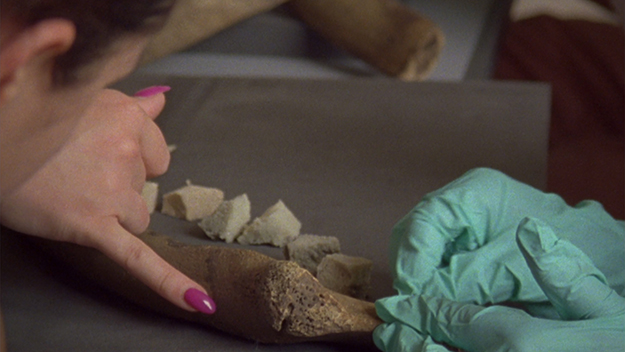
Can you tell me a little about the book and about the wider project as it relates to the film? Were all these components conceived as part of a single project or did one grow from another?
The project has always been three parts: the film, the ceramic replica of the elephant’s tusk, and the book. The book starts with a prologue that introduces different ways of thinking about conservation and the people that are involved in the project who span across various disciplines including non-human agents (bacteria who have the ability to discriminate between materials and remove dust from marble monuments). It then goes into ten chapters—in chronological order, each title is a step in making the ceramic replica—starting from the ivory tusk being removed from the elephant, 3D printing, plaster casting, etc., and ending with the ceramic being donated back to the NHM where the tusk it was replicated from lives. Each chapter describes the process in detail, then expands and veers off into related subjects: ivory laws, the history of zoos compared to museums, my experience with filming animals, other artists and filmmakers who work with objects and museums, the importance of dust and fragments, the reoccurring color of pink and purple, scans of documents between myself and museums, photographs and film stills. It still needs a bit of editing and a publisher.
You mention implicating yourself in the replication process. At what point did that develop into actually including yourself as a ceramicist? And did the process or division of labor change at all in these sequences that feature you—or your hands, at it were?
What it means to be behind or in front of a camera as a filmmaker is always on my mind. The decision to act as a conservator came while watching replicas being made and when reading technical reports where they describe incredible details such as the artist as using their pinkie or thumb to move the clay towards or away from them—the embodiment process I mentioned.
The parts in 4:3, when I was filming conservators working, it was usually just me, occasionally with a sound recordist. With the tusk and my hands it was always Luis Arnías with his camera and voice. During the slip casting process, sculptor Joel Siedner was working with us and instructing me. The restoration of the tusk was at the Straus Center for Conservation at Harvard Art Museums where conservators kindly gave me access and taught me how to use their equipment. We’d either have a sound recordist with us or leave a boom on a tripod when nights of work became long. The plaster mold and ceramic slip casting was a long, physical process over various weeks and nights.
While watching the film a second time I was struck by the beauty and variety of colors on display—not just the nail polish, which naturally draws the eye on first viewing, but the gloves and sponges and textiles. Can you talk about the aesthetic use value of these various practices and processes as it relates to the film, and what the conversations were like with your subjects regarding how they’ll be filmed and what look or aesthetic you’re hoping to achieve?
The two parts of the film are very different. The construction of the tusk is fiction in a way. Whereas with the conservators I was more interested in them, their work and their personal process. I approached them out of curiosity, not with a preconceived idea of how to film them.
We spoke more about their process than filming. I’m fascinated by the materials and tools: where they come from, where and how they are manufactured, whether they are made especially for the practice of conservation, or an unrelated tool that the conservator decided was best for what they were working on (like the nail clipper). These are the instruments of museums and labs, not accessories. The color of the gloves depends on preference of material (latex or nitrile), comfort, or color, or often what the company where the museum buys its stock is producing. With the containers it’s much the same. The choice of color might be the conservator’s aesthetic choice, or a form of cataloguing, or contrasting the lab environment and object with their hands so that after hours of close looking and detailed work, there is no chance of mistaking.
On some occasions I’d visit them without a camera—we’d talk about what they were currently working on or what they had on hand. With Mike Nielson at the British Museum we did a sort of circuit around his workspace—he showed me examples of replicas he had made, what materials he used, then he opened a mold he had set the day before. Sometimes I’d ask him to repeat something so that I could film it. With Erê Oliveira at MAE (Museu de Arqueologia e Etnologia), she was working on tracing that particular urn that day. We spoke about the process and why she had chosen to study patterns this way, then I followed her while she worked.
Tell me about the opening text. The credits say it was inspired by Abbas Kiarostami’s Certified Copy (2010)?
It’s inspired perhaps more specifically by the lecture James gives at the beginning of that film while introducing his new book, also named Certified Copy, whose themes then permeate the film. From the way he introduces himself as not being an expert, to then saying that we are only replicas of our ancestors—that the original is only a reproduction of the girl in the picture.
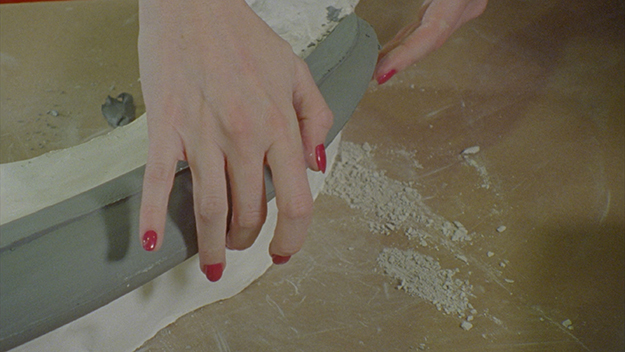
Many of your prior films have prominent voiceover or expository elements, but for the most part the images tell the story in Those That, at a Distance. I’m curious how you conceive of your work in terms of narrative. It feels like in some sense the new film may have been less “written” than some of your past work, but at the same time it’s perhaps even more comprehensively structured in terms of both story and subject.
It’s funny because Those is probably one of the most “written” films I have made in terms of having written the book as part of the project while making the film. Although it isn’t a script, the writing process allowed me to depend on structure differently. From the beginning I deliberately fought against voiceover. For a while I’ve been interested in the conversation, whether constructed or not, substituting the voiceover. My previous film, Black Pond, is a step in that direction where there is both voiceover, conversation, and text. It’s a mixture of me trying to challenge myself and a shift in taste. The voice being separate from the image continues to be crucial, allowing the viewer to imagine a different space through sound from what they are seeing. Luis’ story in Those That, at a Distance about his friend imitating a tree is a good example of this.
I’m interested in the first scene of the film. At a glance it stands apart from the rest of the film, at least stylistically. But at the same time it establishes many of themes you’ll go on to explore. Where was this footage shot and at what point did you think of using it as a kind of prologue?
The footage was shot in the Tijuca Floresta, Rio de Janeiro—the largest urban rainforest. It was deforested in the 18th century for coffee farming and in the 1850s trees began to be re-planted. The re-wilding program continues today with the reintroduction of mammals, including the howler monkey. I spent some time with two biologists, Luisa and César, tracking them—looking at the seeds that they eat, collecting feces, climbing up slopes following the sound of the tracker. Most of the monkeys were previously pets so it is often a struggle for them to become accustomed to living in the canopy—sometimes they are found on the floor being fed by tourists, so they have to go back into their cages (which are in the forest) and start over. I was lucky enough to be there the moment when Luisa found that one of the females, Kala, who had been released a year ago, had recently had a baby.
The scene was always part of the film but I took a while to settle on it as the prologue. There was a moment during the editing, perhaps when I was also writing the opening text, where it found its place, as you say, becoming the perfect establisher of themes that I then go on to explore in the sound and film in general. I also enjoy thinking of it as a bridge from some of my previous films.
The last thing I actually want to ask you about is the sound. I’m sure you get this a lot, but certain elements in your work seem to have something in common with ASMR techniques—even as far back as the whispered voiceover in your first film, Darse Cuenta (2008). Do you have any particular interest in ASMR? And even if not, what in general is it about the sensory properties of sound that fascinates you?
I’m not sure how comfortable I am with the reference. My earlier work, including Darse Cuenta, pre-dates the phenomenon and it was first mentioned after someone had seen Those That, at a Distance—I had to look it up. It’s the sensationalism that puts me off perhaps, and the element of classification. It feels like a simplifying of the film but maybe there is something interesting there if someone were to flesh it out—there might even be a link between Nulepsy and ASMR, I don’t know!
I equate the closeness of sound with the closeness of the images. In Those That, at a Distance, there are two sound spaces just as there are two visual spaces. With the replica tusk scenes, there are sounds of me, Luis, and Joel working: listening to music, instructing, telling stories. In the parts where other people or “experts” are working, I did Foley, replicating their sounds. I work with sound designer Philippe Ciompi—we wanted there to be an evident shift between both spaces but not something jarring. At first we laid the Foley in with minimal atmosphere, a vacuum of close sounds. I wanted the exterior world to come in, the multiple flora, fauna, and minerals that have been used by artists throughout centuries and consequently by conservators, including the ground up bones that form the gelatin on the 16mm film I was shooting with. We layered sounds from forests, animals, seas, insects, etc., which Philippe then manipulated. When you’re seeing Nigel sand down the bit of ivory that he uses to restore the jewelry box, I want the viewer to be taken to where that material came from.
Jordan Cronk is a critic and programmer based in Los Angeles. He runs Acropolis Cinema, a screening series for experimental and undistributed films, and is co-director of the Locarno in Los Angeles film festival.



